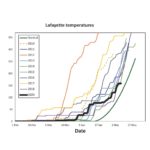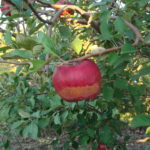As we’ve talked about previously, once winter chilling is fulfilled, the rate of tree growth and development is largely dependent on temperature. This is clearly evident in the data over the last 10 years (see Figure 1). In 2012, we had an extremely early and warm spring, rapid accumulation of Growing Degree Days, and very early development. Fruit crops in Lafayette flowered in March, about a month early. As we all remember this was followed by spring freezes resulting in extensive crop loss.
OK, so enough of the history lesson. What’s happening this year? Well spring started at about the mid-range of the last few years then cooler temperatures arrested bud development. Normally having the latest spring for 10 years would be a good thing, because it reduces the risk of freeze damage. But the problem we have this year is that early warm temperatures pushed buds to the flowering stage or a little beyond, and now we need warm conditions for pollination, fertilization, fruit set and chemical thinning. So here we are with orchards full of trees in bloom or even past petal fall, and cool conditions forecast for the 5-7 days. On top of that, freezing conditions are predicted for tomorrow evening.
We know that most of our chemical thinners are not very effective when applied in cool temperatures (below 65 F). Research by Dr. Rich Marini at Penn. State University showed that it’s not just the temperature at the time of application that’s important, but the temperatures two days earlier through to one day after application, so we need about a four-day window of warm temperatures for thinning to be most effective. In most places in the state, we don’t have that now and are unlikely to have this for another week or so. The good news is that with cooler conditions, fruit will not be growing very much, so hopefully most fruitlets will not outgrow the thinning window of around 12 mm diameter during this cool spell.
As for the freeze damage, well we already experienced quite a bit of damage around the state on April 15-16, with lows in the lower 20’s. For the predicted upcoming freeze, the amount of damage depends on many factors, but the most important are 1. How cold it gets 2. The stage of crop development, and 3. How long the temperatures stay below freezing. Fruit are killed when the ovule or developing seeds are killed by cold. As the fruitlets develop, they have an increased amount of tissue around seeds to protect them, and are less likely to be killed by freezing conditions. However, temperatures below freezing can also cause cosmetic damage to fruit, sometimes resulting in the classic russeted frost rings (Figure 2). In many cases, this will render fruit into cider apples, but some slight amount of cosmetically-damaged fruit may be saleable at farm markets.
- Figure 1
- Figure 2

